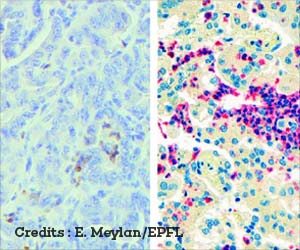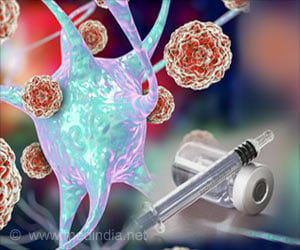Newly identified biomarkers in the blood can act as specific inhibitors to distinguish cancer cells as foreign bodies and predict their response to immunotherapy
A novel method has been identified to find out which patients are likely to respond positively to immunotherapy. Immunotherapy can fight effectively against melanoma and lung cancer. It makes targeted use of normal immune system functioning with regular examination of body's tissue for pathogens and damages. Specific inhibitors can be used to activate immune cells and identify cancer cells as foreign bodies. Thus eliminating the metastatic cancer cells. Immunotherapy can be possibly used to control cancer cells in up to 50 percent of patients, in some cases even curing them altogether says the research team at University of Zurich. The findings in the study are published in the journal of
Nature Medicine.//
Not all respond to immunotherapy
TOP INSIGHT
The new biomarkers identified in the blood through bio banking, high-dimensional cytometry, and computer-aided pattern recognition can be useful in predicting cancer patient’s immune response.
However, around half of cancer patients do not respond to immunotherapy, but still have to put up with its side effects. Researchers from the University of Zurich and the University Hospital Zurich were able to identify biomarkers in the blood that indicate whether the therapy is highly likely to be effective even before treatment is commenced.
"The blood counts of patients should be analyzed for these biomarkers when making a decision about immunotherapy. This will dramatically increase the share of patients who will benefit from this type of therapy," says Professor Burkhard Becher from the Institute of Experimental Immunology at UZH. "At the same time, it makes it possible to directly move on to different methods in cases where immunotherapy won't work - without losing valuable time."
High-dimensional cell analysis
The scientists worked hand in hand with the Department of Dermatology of the University Hospital Zurich to examine biomarkers in 40 blood samples of 20 patients, both before and 12 weeks after immunotherapy. For this, they used the high-dimensional "cytometry by time of flight" (Cy-TOF) cell analysis method, which analyzes cells for up to 50 different proteins one cell at a time. The researchers were thus able to differentiate every single cell and document its activation status. Even nuanced differences between the patient samples were recorded in detail.
Recognizing molecular patterns
After analyzing the cells, the researchers examined the data together with employees of the Swiss Institute of Bioinformatics at UZH in terms of molecular patterns that could predict therapeutic success. "Even before the start of a therapy, we observed a subtle and weak immune response in the blood, and identified this molecular pattern as the immune cells CD14+CD16−HLA-DRhi," says Burkhard Becher. For the finding to be easily verifiable, the biomarkers should be easily detectable; indeed, the blood count was able to be validated using conventional methods in a second, independent cohort of more than 30 people.
Dawning of precision medicine
"Together with comprehensive, precisely structured bio banking, this study represents a major step towards precision medicine," says Professor Mitch Levesque of the Department of Dermatology at the University Hospital Zurich. Before they can be used clinically, the insights gained must now be applied in independent studies with higher patient numbers. The method using biobanking, high-dimensional cytometry, and computer-aided pattern recognition should also be useful in clinical decision support and developing new therapeutic approaches when it comes to other clinical pictures.
Source-Eurekalert

 MEDINDIA
MEDINDIA




 Email
Email










